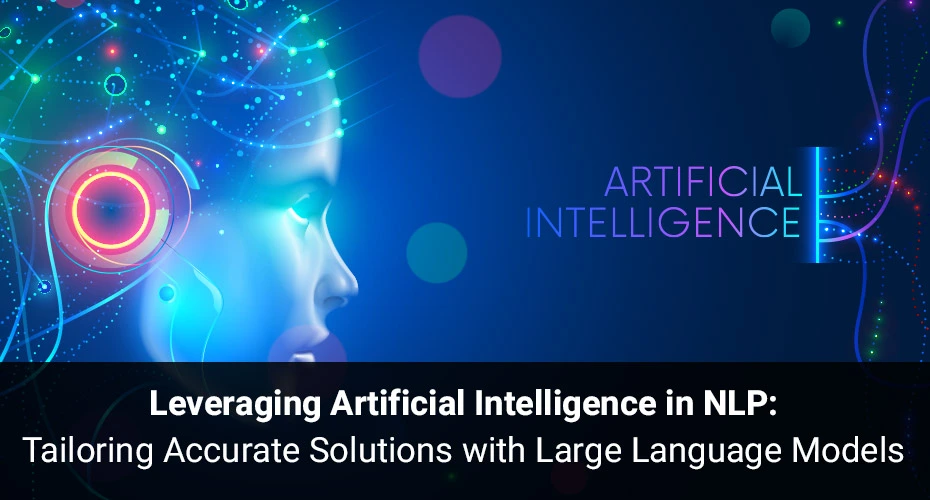July 5, 2023 - by Anish Purohit
Artificial Intelligence (AI)-powered chatbots like ChatGPT and Google Bard are experiencing a surge in popularity. These advanced conversational software tools offer a wide range of capabilities, from revolutionizing web searches to generating an abundance of creative literature and serving as repositories of global knowledge, sparing us from the need to retain it all. They are examples of Large Language Models (LLM) and have caused a lot of excitement and talk in 2023. Ever since its inception, every business (and user) has been looking to adopt LLMs in some way or another.

But generating the right results from LLMs isn’t straightforward. It requires customizing the models and training them for the application in question.
This blog explains LLMs and how to adjust them for better results in specific situations.
What Are Large Language Models?
LLMs, powered by Artificial Intelligence, are pre-trained models that understand and generate text in a human-like manner. They allow businesses to process vast amounts of text data while continuously learning from it. When trained on terabytes of data, they can recognize patterns and relationships in natural human language.
There are several areas where organizations can use LLMs:
- Natural Language Understanding: LLMs offer a great way to understand natural language text and generate responses to queries. This is useful for building chatbots and virtual assistants to interact with users in their natural language.
- Text Generation: LLMs can generate text similar in style and content to the training data. This is useful for generating product descriptions, news articles, and other types of content.
- Machine Translation: Data scientists can train LLMs on parallel masses of text in two languages and translate text from one language to another.
- Sentiment Analysis: Data experts can also train LLMs on labeled examples of text to classify text as positive, negative, or neutral. This is useful for analyzing customer feedback and social media posts.
- Text Summarization: Data teams can use LLMs to summarize long documents into shorter summaries, which is useful for news articles and research papers.
How Do Large Language Models Work?
In general, LLMs must be trained by feeding them with large amounts of data. Data could come from books, web pages, or articles. This enables LLMs to establish patterns and connections among words, enhancing the model’s contextual understanding. The more training a model receives, the better it gets at generating new content.
What Are the Pros and Cons of LLMs?
LLMs offer several benefits to unlock new possibilities across diverse areas, including NLP, healthcare, robotics, and more.
- LLMs like ChatGPT can understand human language and write text just like a human. This has made them particularly effective in tasks such as language translation without requiring extensive manual intervention.
- LLMS are known for their versatility. Right from chatbots that can hold conversations with users to content-generation tools that can write lengthy articles or product descriptions.
- Many organizations also invest in LLMs as they reduce the time and cost of developing NLP applications. Based on the knowledge gained from massive datasets, pre-trained LLMs can recognize, summarize, translate, predict, and generate text and other forms of content.
While LLMs deliver remarkable results, they may not always provide optimal results for specific applications or use cases. As the language used in different domains may vary, customization becomes vital.
What Is Customization of Large Language Models?
Customization of LLMs involves fine-tuning pre-trained Artificial Intelligence models to adapt to a specific use case. It involves training the model with a smaller, more relevant data set specific to a unique application or use case. This allows the model to learn the language used in the specific domain and provide more accurate and relevant results.
Customization also brings much-needed context to language models. Instead of providing a response based on the knowledge extracted from training data, data scientists can allow for much-needed behavior modification based on the use case.
What Are the 5 Applications of Customized Large Language Models?
Customization of LLMs has many applications in various fields, including:
1. Customer Service
Customizing LLMs for chatbots can provide accurate responses to customer queries in specific domains, such as finance, insurance, or healthcare. This can improve the customer experience by providing more relevant and timely responses.
2. Social Media Analysis
LLMs customization can analyze social media data in specific domains, such as politics, sports, technology, innovation, or entertainment. This can provide insights into trends and sentiment in the required domain.
3. Legal Case Analysis
Customized LLMs can help analyze legal documents and provide insights into legal cases. This can help lawyers and other legal professionals identify relevant cases and precedents.
4. Healthcare Sector
Customizing LLMs can help analyze medical data and provide insights into patient care. This can help healthcare professionals spot patterns and trends in medical data.
5. Marketing Ops
Customized LLMs can also be used in advertising and marketing to create content effortlessly. They can also help suggest new ideas or titles that can attract targeted customers and improve the chances of conversion.
How Can You Customize LLMs?
Customization of LLMs involves two main steps: preparing the data and fine-tuning the model.
- Preparing the data: The first step in customizing LLMs is to prepare the data. This involves gathering a relevant dataset that is specific to the use case. The data set should not be too large or too short to avoid time complexity and model accuracy. The data also needs to be labeled to allow the model to learn from labeled examples.
- Fine-tuning the model: The second step in customization is to fine-tune the pre-trained model on the specific dataset. This involves taking the pre-trained model and training it further on the smaller, more relevant dataset. The fine-tuning process involves feeding the model with labeled examples of text data for the specific use case. This allows the model to continuously learn and generate text that is relevant to the domain.
Customizing LLMs powered by Artificial Intelligence offers an efficient way to enable accurate and relevant results for specific NLP use cases. As more data becomes available, customization of LLMs will become increasingly important for improving the performance of NLP models. When done by skilled data scientists, organizations can easily find loopholes and bridge gaps leveraging their technical and analytical thinking.
About the Author
Anish Purohit is a certified Azure Data Science Associate with over 11 years of industry experience. With a strong analytical mindset, Anish excels in architecting, designing, and deploying data products using a combination of statistics and technologies. He is proficient in AL/ML/DL and has extensive knowledge of automation, having built and deployed solutions on Microsoft Azure and AWS and led and mentored teams of data engineers and scientists.




